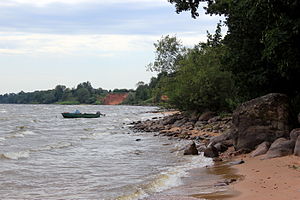Lake Peipus
| Lake Peipus | ||
|---|---|---|

|
||
| Coast of the lake in Kallaste | ||
| Geographical location | between Estonia and Russia | |
| Tributaries |
Emajõgi , Võhandu , Welikaja and about 30 others |
|
| Drain | Narva | |
| Places on the shore |
Kallaste , Mustvee
Pskov ( Pleskau ) |
|
| Data | ||
| Coordinates | 58 ° 41 ′ N , 27 ° 30 ′ E | |
|
|
||
| Altitude above sea level | 30 m above sea level Baltic Sea | |
| surface | 3 555 km² | |
| Maximum depth | 14.6 m | |
|
particularities |
rich in fish |
|
The Peipussee ( Estonian Peipsi Pihkva järv ; Russian Псковско-Чудское озеро or Чудско-Псковское озеро , Pskowsko-Tschudskoje Ozero or Tschudsko-Pskowskoje Ozero , " Pskov -and- Chud -See") is a between Estonia and Russia located inland waters . With 3555 km² it is about seven times the size of Lake Constance and ranks fifth among the largest lakes in Europe - after Lake Ladoga and Lake Onegain Russia as well as the Swedish Vänern and the Finnish Saimaa .
Geography and climate
The Peipussee is divided into three parts from north to south:
- The northern part forms the 2610 km² large lake (Estonian Peipsi järv or Suurjärv , Russian Чудское озеро Tschudskoje osero ), which is referred to in many maps as the actual Peipus lake.
- In the middle is the warm lake (Estonian Lämmijärv , Russian Тёплое озеро Tjoploje osero ), with 235 km² the smallest part.
- The southern part, the 710 km² large Pleskauer See (Estonian Pihkva järv , Russian Псковское озеро Pskowskoje osero ) is almost entirely enclosed by Russian territory.
The lake extends over 143 km in north-south direction and is up to 50 km wide. Together with the Narva , its drain to the Baltic Sea , it forms almost the entire eastern state border between Estonia and the Russian Federation and has therefore also been part of the external border of the European Union since May 1, 2004 . 1570 km² (44%) of the total area is on Estonian territory, the greater part belongs to Russia. It has over thirty mostly smaller tributaries.
The Peipussee is on average only 8 m deep; the deepest point is almost 15 m in the Pleskauer See. Thanks to its shallow depth, it warms up to 22 ° C in summer. In winter, Lake Peipus usually freezes over. The ice cover can be a maximum of 50 to 60 cm thick in March and lasts the longest on the northern Great Lake. The snowmelt in spring causes the water level to rise by up to 1 m. By flooding its very sparsely populated bank zone, the surface of the lake increases by up to 780 km².
Economic use
The Peipussee is very rich in fish despite increasing environmental pollution. The average annual catch is around 10,000 tons. In summer, the relatively shallow body of water is also very popular as a bathing lake, especially on the northern section of the bank between the towns of Kauksi and Vasknarva, which is lined with wide sand dunes and forests . There are some simply equipped campsites (telklaager). Except for the easily accessible north bank, the lake is hardly used for tourism.
History and culture
The battle on Lake Peipus was of great historical importance : on April 5, 1242, a Russian army under the Novgorod Prince Alexander Nevsky defeated the German and Danish crusaders of the Teutonic Order and the Order of the Brothers of the Sword and their Estonian allies on the ice of the frozen lake .
A regionally significant minority of Old Believers lives on the west bank of the lake . At the end of the 17th century, their ancestors came as religious refugees from the Russian Empire to what was then Swedish Estonia. To this day, the Russian-speaking Old Believers who cultivate special religious and cultural customs make up the majority of the population in some places along the lake, e.g. B. in the so-called "onion villages " Varnja , Kasepää and Kolkja .

